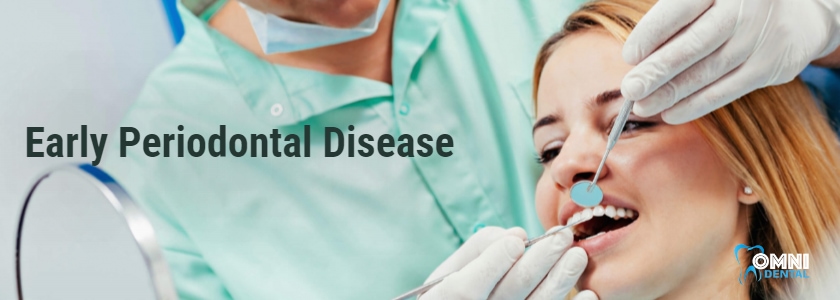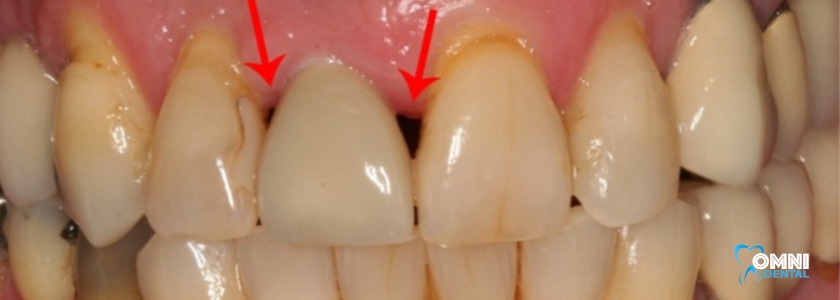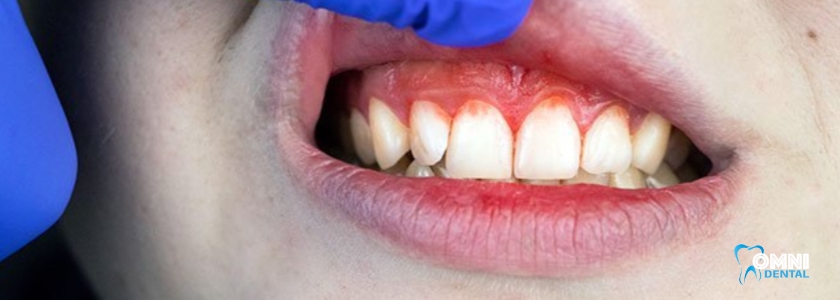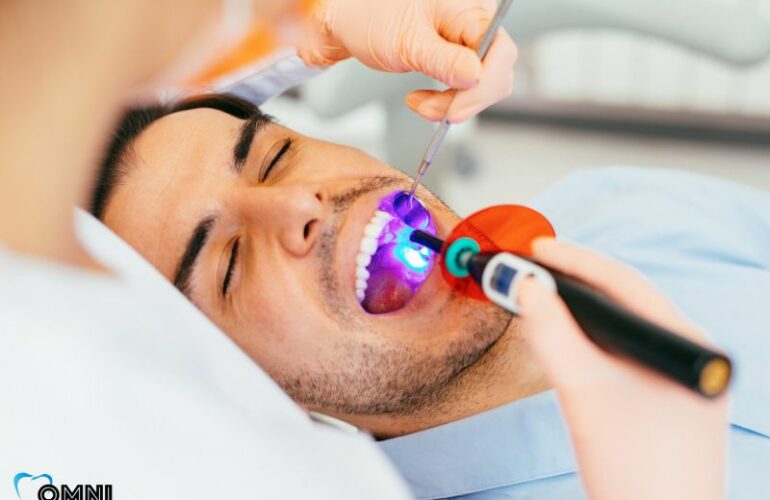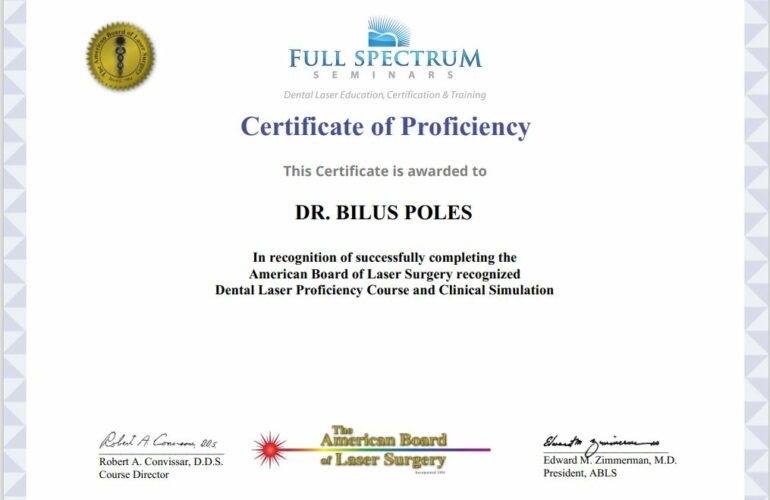85% of US adults have gum disease. And you just found out that you are one of them. There are a variety of treatment options, all with a common goal: killing the germs, removing the infection and closing up the pockets.
The first recommendation for treatment for the early stages of periodontal disease is usually deep cleaning of all your teeth. Your dental care professional divides the mouth into four quadrants and treats each one in turn. After numbing the gums, the dentist or dental hygienist cleans the root surfaces below the gum line of your teeth to remove calculus, as well as smooth and reduce the germs on the root. Also known as scaling & root planing, the treatment attempts to stop infection for progressing. However, it cannot regrow any lost bone or collagen or close the pocket that has formed there. Bacteria can still collect in the spaces between the tooth and gum, allowing germs to multiply and attack the collagen and bone again.
If your early stage gum infection treatment does not work entirely or the disease is moderate or severe, which means many more germs are present than the early stages, your dentist may recommend gum surgery.
Despite following good oral hygiene practices and making other healthy lifestyle choices, the American Academy of Periodontology says that up to 30% of Americans may be more likely to get gum disease because of their genes. And those who are genetically predisposed may be up to six times more likely to get some form of gum disease. If anyone in your family has gum disease, it may mean that you are at greater risk as well. If you are more likely to have gum disease, your dentist or periodontist may recommend more frequent checkups, professional cleanings, and treatments to better manage the condition.
If it’s been 6 months since you last saw the dentist, set up a cleaning to remove tartar and plaque buildup from your teeth. Ask your dentist about the proper way to brush. Bearing down too hard or missing spots can lead to gingivitis. After a cleaning, your gums should get better within a week or so as long as you brush twice a day, and floss and rinse once a day.
Plaque is essentially the start of gum disease problems. Plaque buildup caused by bacteria in the mouth and particles from the foods you eat every day.
Once sugars are introduced to plaque, it turns into a tooth eating acid that sits just above the gum line. If regular oral care isn’t standard, the acid will start eating at the teeth producing cavities and the plaque can cause gum disease.
Plaque that is allowed to sit for a prolonged period of time can cause cavities, gingivitis, and other problems in your mouth. If it’s left longer than that, serious dental procedures may be required to restore your decaying smile.
SIGNS OF PERIODONTAL DISEASE
Protecting your smile is not just about teeth that are pearly-white or perfectly aligned. Your gums are an integral part of the equation, for your oral health as well as your overall health. The symptoms of gum disease, also referred to as periodontal disease, are usually painless in the beginning and can make their home among cavity-free, white teeth. Periodontal disease is not to be taken lightly, as it has been associated with an increased rate of heart disease, stroke, diabetes, certain cancers, and tooth loss.
The good news is that gum disease is preventable with proper dental care. The first step in combating gum disease is to enlist the help of an experienced dental professional like Dr. Jeffrey Allred in San Marcos, CA. He features extensive knowledge and training to expertly aid in the diagnosis and treatment of dental issues. Learn more about gum disease and some of its most obvious signs so you can seek treatment early on.
Early Warning Signs of Periodontitis
Causes
In most cases, the development of periodontitis starts with plaque — a sticky film composed mainly of bacteria. If left untreated, here’s how plaque can eventually advance to periodontitis:
- Plaque forms on your teeth when starches and sugars in food interact with bacteria normally found in your mouth. Brushing your teeth twice a day and flossing once a day removes plaque, but plaque re-forms quickly.
- Plaque can harden under your gumline into tartar (calculus) if it stays on your teeth. Tartar is more difficult to remove and it’s filled with bacteria. The longer plaque and tartar remain on your teeth, the more damage they can do. You can’t get rid of tartar by brushing and flossing — you need a professional dental cleaning to remove it.
- Plaque can cause gingivitis, the mildest form of gum disease. Gingivitis is irritation and inflammation of the part of your gum tissue around the base of your teeth (gingiva). Gingivitis can be reversed with professional treatment and good home oral care.
- Ongoing gum inflammation can cause periodontitis, eventually causing pockets to develop between your gums and teeth that fill with plaque, tartar and bacteria. In time, these pockets become deeper, filling with more bacteria. If not treated, these deep infections cause tooth loss or loss of tissue and bone, and ultimately you may lose one or more teeth. Also, ongoing chronic inflammation can put a strain on your immune system.
Risk factors
Factors that can increase your risk of periodontitis include:
- Gingivitis
- Poor oral health habits
- Smoking or chewing tobacco
- Hormonal changes, such as those related to pregnancy or menopause
- Recreational drug use, such as smoking marijuana or vaping
- Obesity
- Inadequate nutrition, including vitamin C deficiency
- Genetics
- Certain medications that cause dry mouth or gum changes
- Conditions that cause decreased immunity, such as leukemia, HIV/AIDS and cancer treatment
- Certain diseases, such as diabetes, rheumatoid arthritis and Crohn’s disease
What Are the Symptoms of Gum Disease?
Gum disease may progress painlessly, producing few obvious signs, even in the late stage of gum disease. Although the symptoms of periodontal disease often are subtle, the condition is not entirely without warning signs. Certain symptoms may point to some form of the disease. The symptoms of gum disease include:
- Gums that bleed during and after tooth brushing
- Red, swollen gums. Healthy gums should be pink and firm.
- Persistent bad breath or bad taste in the mouth
- Receding gums
- Formation of deep pockets between teeth and gums
- Loose or shifting teeth
- Changes in the way teeth fit together upon biting down, or in the fit of partial dentures
Even if you don’t notice any symptoms, you may still have some degree of gum disease. In some people, gum disease may affect only certain teeth, such as the molars. Only a dentist or a periodontist can recognize and determine the progression of gum disease.


